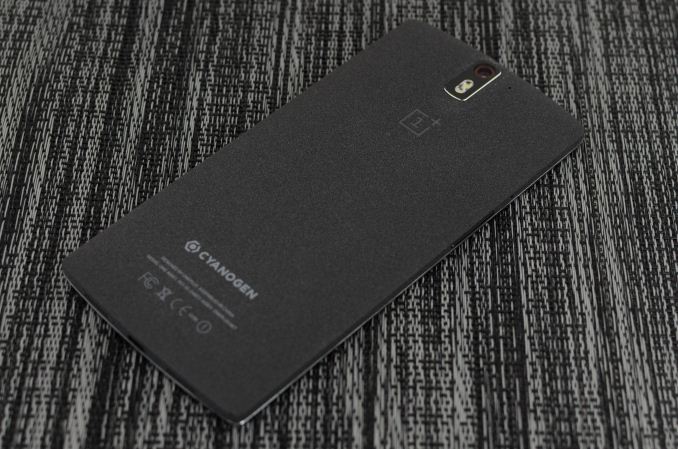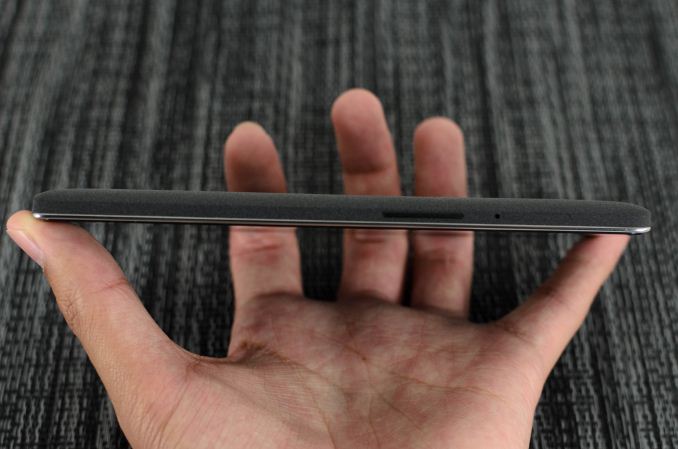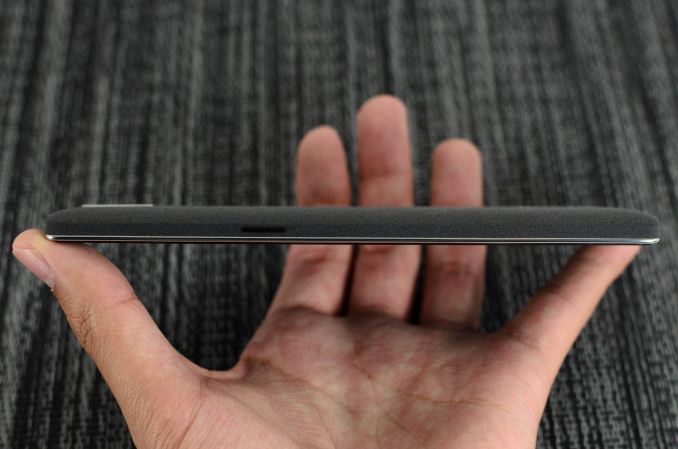The OnePlus One Review
by Joshua Ho on November 19, 2014 8:00 AM EST- Posted in
- Smartphones
- Android
- Mobile
- OnePlus

The OnePlus One has been one of the most hyped smartphones of 2014. There's really not much else to be said, as OnePlus' marketing has been quite noticeable amongst Android enthusiasts. The OnePlus One seems to come from nowhere, although there is a noticeable resemblance to the Oppo Find 7A which is produced in the same factory. The OnePlus One is said to be a flagship killer, as its high-end specs come with a mid-range price. The 16GB version starts at 299 USD and the 64GB version starts at 349 USD. With a 5.5" 1080p display, Snapdragon 801 SoC, and plenty of other bits and pieces to go around, the specs are certainly enough to make it into a flagship phone. Of course, the real question is whether it really is. After all, while specs provide the foundation, what makes a phone bad, good, or great has to do with the entire phone, not just the spec sheet. At any rate, I've attached this spec sheet below to give an idea of what to expect from the phone.
| Oppo Find 7a | OnePlus One | |
| SoC | MSM8974ABv3 2.3 GHz Snapdragon 801 |
MSM8974ACv3 2.45 GHz Snapdragon 801 |
| RAM/NAND | 2 GB LPDDR3, 16GB NAND + microSD | 3GB LPDDR3, 16/64GB NAND |
| Display | 5.5” 1080p IPS LCD (JDI) | 5.5” 1080p IPS LCD (JDI) |
| Network | 2G / 3G / 4G LTE (Qualcomm MDM9x25 UE Category 4 LTE) | 2G / 3G / 4G LTE (Qualcomm MDM9x25 UE Category 4 LTE) |
| Dimensions | 152.6 x 75 x 9.2 mm, 170 grams | 152.9 x 75.9 x 8.9 mm, 162 grams |
| Camera | 13MP (4128 x 3096) Rear Facing, 1/3.06" CMOS size (Sony IMX214), F/2.0, 5MP FFC w/ F/2.0 aperture | 13MP (4128 x 3096) Rear Facing, 1/3.06" CMOS size (Sony IMX214), F/2.0, 5MP FFC w/ F/2.0 aperture |
| Battery | 2800 mAh (10.64 Whr) | 3100 mAh (11.78 Whr) |
| OS | Android 4.3 with ColorOS | Android 4.4.4 with CyanogenMod 11S |
| Connectivity | 802.11a/b/g/n/ac + BT 4.0, USB2.0, GPS/GNSS, DLNA, NFC | 802.11a/b/g/n/ac + BT 4.0, USB2.0, GPS/GNSS, DLNA, NFC |
| SIM Size | MicroSIM | MicroSIM |
Needless to say, the OnePlus One is a close cousin of the Find 7a, and its specs are top notch. There's a great foundation, so we'll move on with some initial hardware impressions.
Of course, the first part to look at is industrial and material design, along with any other immediate observations about the phone. From the front, the phone is almost a pure expanse of black glass. There are outlines for the capacitive keys, but these are quite faint most of the time. The contrast of the silver plastic ring only emphasizes this, and the lack of logos helps to make the design stand out by virtue of its minimalism. Picking it up, the feel of the sandstone black finish is incredibly unique and unlike anything I've ever felt. The finish has been described as soft sandpaper, and that's a description I'd agree with. It makes the phone feel much grippier than one might expect. The back cover is also strong, with no real give and no flex. Other than a few logos, the only significant design elements on the back are the camera, dual LED flash, and a hole for the microphone. The front of the phone has surprisingly great attention to detail as well. The silver plastic piece on the front of the phone makes the finger smoothly roll off of the display when swiping around, and the imperceptible feel of the earpiece helps to contribute to the sense that this is a single, well-built phone.
On the sides, the minimalistic theme continues. There's only a power button on the right side, a headphone jack and microphone port on the top, and a volume rocker on the left side. The SIM tray is also on the left side, and on the bottom of the phone we see two speakers, a USB port, and a microphone hole. In general, the feel of the power and volume buttons are great, with no slack and a clean, if subdued click upon activation.
Needless to say, OnePlus has done a fantastic job. However, there are a few issues to talk about. First, the size is definitely too much to handle. If the LG G3 was at the very edge between a phone and phablet, the OnePlus One firmly steps into phablet territory. At some point a line in the sand has to be drawn, and it only makes sense to do so here. The angular corners of the OnePlus One combined with its larger footprint makes for a phone that is almost impossible to comfortably use with one hand. I can't help but feel that this would've been a far more impressive phone if shrunk to a 5" display size, as in my experience it takes two hands to comfortably use this phone. The other issue is much more subtle though. For some reason or another, the glass lens covering the display of the phone feels as if it has noticeably higher friction than other phones I've used. It almost feels as if the oleophobic treatment of the glass is either missing or thinner than most. Of course, overall the phone is great from a basic design perspective. The size seems to be a matter of OnePlus' start-up position and the need to share parts with the Find 7a, although the feel of the glass is unlikely to be an issue for most.













148 Comments
View All Comments
Iseek1 - Friday, November 21, 2014 - link
@Joshua Ho a lot of people are amazed / confused over the battery test results, the incredible high numbers for screen on time and battery life in general per these tests, would you possibly be able to go into more detail as to how these tests are done?dragospascu - Saturday, November 22, 2014 - link
glad that my irk with benchmarking in balance mode was addressed ; also the size "issue" :)i have it for 2 months now and can't let it rest.....my nexus 7 is full of dust :)
i just hope they'll manage to ramp up production so all other manufacturers will be forced to reconsider their profit margins. i think everybody should cheer them up :)
shainawilliams1992 - Saturday, November 22, 2014 - link
OnePlus One is now on sale only at http://tinyurl.com/mrq34ostheduckofdeath - Saturday, November 22, 2014 - link
" While contrast with viewing angle changes isn't as good as AMOLED panels, I don't see any color shifting with viewing angle changes. This seems to remain an advantage of IPS panels for now."You know you're reading a review on iAnandtech when the writers tries to find every little scrap to be able to pretend LCD is on par with AMOLED in 2014.
Socius - Saturday, November 22, 2014 - link
IPS displays are actually superior to amoled with the exception of black levels and contrast...theduckofdeath - Thursday, November 27, 2014 - link
The extreme difference in dynamic range (by a factor of 1000 to 1) makes the theoretical minute differences in "colour accuracy" that Anandtech WRONGLY finds in their comparisons, completely irrelevant.Anandtech's flawed tests has often been openly criticized by professional display testers as being inaccurate. For instance by Displaymate, which all manufacturers use to test and calibrate their displays.
AnnonymousCoward - Saturday, November 22, 2014 - link
The color white is still better on LCD than OLED. And OLED phosphors age.theduckofdeath - Thursday, November 27, 2014 - link
I have never, ever had any issues with aging of AMOLED displays. I really think you need to update your sources. The absolute first generation of OLED had aging issues. That was 6-7 years ago.LCD displays age and bleach, too. My old laptop (which is around 4 years) with an LCD has issues showing the difference in low contrast areas, which is a big problem with all these modern/material themed sites and apps these days.
AnnonymousCoward - Friday, November 28, 2014 - link
> you need to update your sourcesMy source is myself! My 2.5 year old Samsung phone has faint spots all over that are marginally visible when the whole screen is a dark color.
pliablemoosethebanned - Saturday, November 22, 2014 - link
I've had a couple of OPO's, and thought they were a great phone, particularly when you factor in the price.